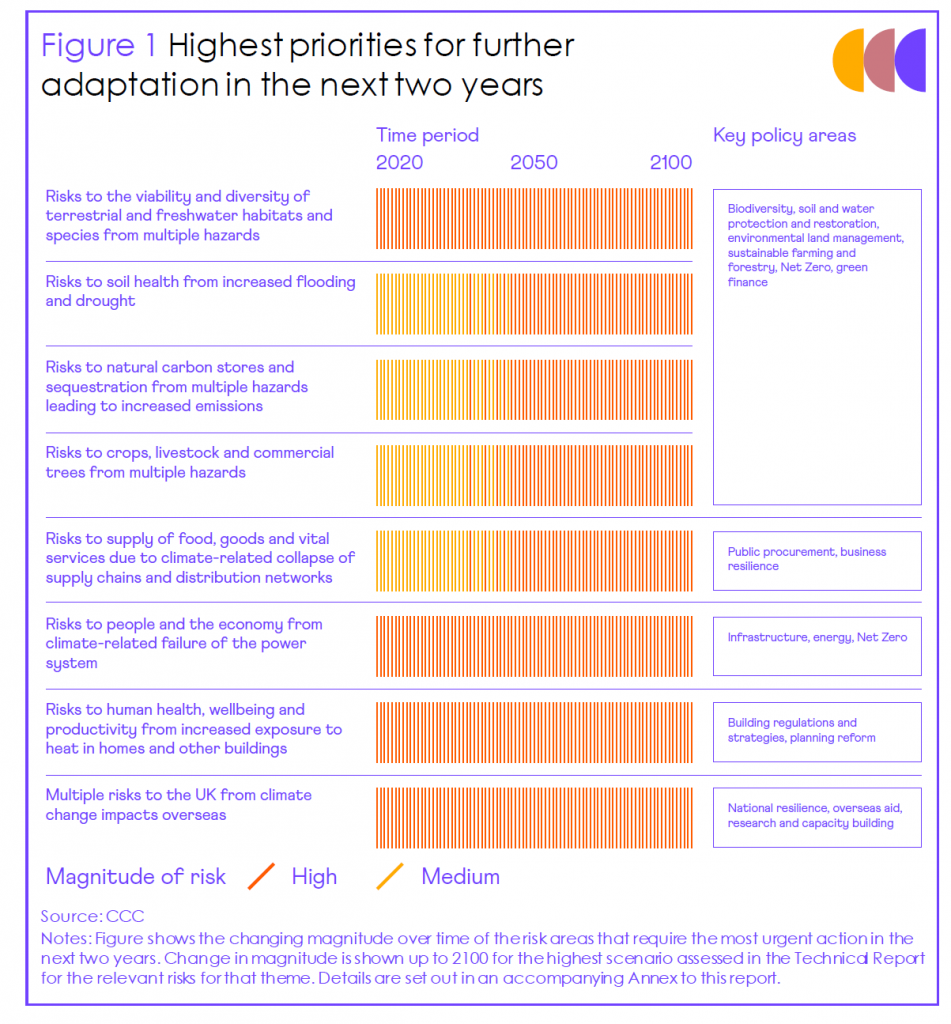
The Climate Change Committee(CCC), the UK Government’s independent climate advisor, has recently released its third official climate change risk assessment(CCRS3) since the 2008 climate change act[2]https://bills.parliament.uk/bills/195 was introduced. This report accumulates almost 3 years of extensive research, analysis and consideration, and the overwhelming conclusion drawn from the study is that the impacts of climate change on the UK are currently outpacing the actions taken to adapt to change.
According to the CCC, since the last climate review in 2017, rather than limiting damage, the gap between climate risks and adaptation measures has grown even larger. Due to this, the CCC says the government will need to take urgent climate resilience measures in order to succeed in hitting the net zero by 2050 goal. At Project Vana, we believe that we can help increase the rate at which action is taken through use of data and connecting up the relevant networks.
CCC chief executive Chris Stark commented that “We will fail on net-zero and we will fail to improve the environment overall if we don’t factor in the changes in the climate that are coming by 2050.” This perspective draws on concerns that, to reach climate targets we must additionally account for environmental changes that have already impacted the UK climate. The CCC highlights the importance of protecting existing carbon stores as the climate warms[3] https://www.theccc.org.uk/publication/independent-assessment-of-uk-climate-risk/, warning that hotter and drier conditions could threaten the forests that we depend upon to remove carbon from the atmosphere, in our quest for net-zero by 2050.
At Vana, our hypothesis predicted that corporate landowners are significant players in helping to achieve UK afforestation and nature rewilding targets. We were able to prove this hypothesis true, by finding that UK corporates own a total of 235,606 hectares of woodland opportunity land, providing more than enough suitable land needed to hit UK tree planting targets, as laid out in the 25 Year Environment Plan. The more woodland we can create across the UK, the more carbon capturing stores we can accumulate to drive down global warming related risks, as outlined in the CCRA3.
The CCRS3 covers 61 climate change impacts covering all aspects of life in the UK, with nearly 60% of the risks and opportunities assessed in the 1500-page report now categorised under the highest urgency score. This is an increase of 14 extra risks listed as highest urgency, compared to the previous 2017 Climate Change Risk Assessment. The CCC drew focus onto eight priority risk areas which need immediate attention, at the latest in the next two years. Unsurprisingly, a large proportion of the priority risk areas outlined in the CCRA3 cover risk to the natural environment. At Vana, we have identified a number of risk areas in which our open data platform can help.
As reported by the CCC, the top risks needing immediate action are:
- Risks to the viability and diversity of terrestrial and freshwater habitats and species from multiple hazards.
- Risks to soil health from increased flooding and drought.
The Vana engine is already powerful enough to pull in other data sets and overlay them to address other environmental targets. We are able to apply Vana to flood risk data layers, in order to assess flood risk mitigation through the corporate land and building ownership lens.
- Risks to natural carbon stores and sequestration from multiple hazards, leading to increased emissions.
With peatland data, we can help to protect what we already have and identify owners of land that could benefit from nature restoration.
- Risks to crops, livestock and commercial trees from multiple climate hazards.
With farming being the dominant land use in the UK, covering 72% of total UK land area[4]https://www.woodlandtrust.org.uk/media/49731/state-of-the-uks-woods-and-trees-2021-the-woodland-trust.pdf. Utilising this land for agroforestry could provide enormous benefits carbon sequestration. Agroforestry has also been proven to have multiple benefits for nature and farming productivity[5]https://www.woodlandtrust.org.uk/media/49731/state-of-the-uks-woods-and-trees-2021-the-woodland-trust.pdf, such as supporting pollination, shelter and symbiosis across crops. Tree cover can also support flood mitigation and protect soil against erosion[6]https://www.woodlandtrust.org.uk/media/1700/agroforestry-in-england.pdf. The CCC have recommended that 10% of agricultural land should be used for agroforestry by 2050, compared to only 3.3% currently in use[7]https://www.woodlandtrust.org.uk/media/49731/state-of-the-uks-woods-and-trees-2021-the-woodland-trust.pdf.
With peatland data, we can help to protect what we already have and identify owners of land that could benefit from nature restoration.
- Risks to supply of food, goods and vital services due to climate-related collapse of supply chains and distribution networks.
Vana is built on the open data infrastructure of our corporate transparency platform, TISCreport. The live supply chain data we hold from TISCreport will inform the Vana engine and improve visibility of supply chain risks.
- Risks to people and the economy from climate-related failure of the power system.
Furthermore, with HM Land Registry data we are able to identify corporate building owners to highlight areas in which uptake of adaptation measures could mitigate this risk.
- Risks to human health, wellbeing and productivity from increased exposure to heat in homes and other buildings.
The CCC warns that impacts of global warming, such as heatwaves and floods, are set to increase even further in scale and frequency, even if emissions are cut within targets[8]https://www.gov.uk/government/news/uk-becomes-first-major-economy-to-pass-net-zero-emissions-law. Hotter and drier conditions could threaten existing woodland that would otherwise remove significant volumes of carbon from the atmosphere. Healthy carbon-capturing forests are essential in reaching our 2050 net-zero target and, as our main method of reducing the earth’s rising temperatures, protecting our woodland is essential to hitting UK climate goals.
Vana’s connected data infrastructure is built to identify opportunities across the UK for nature restoration via afforestation and reforestation. Vana is the corporate CareBnB for climate repair: connecting corporates to the data ecosystem and community action groups they need to support rapid achievement of nature restoration targets. The estimated environmental outcome from our mission would capture an extra 76+ tonnes of carbon over 50 years, enabling us to achieve the 2042 tree planting target within 10 years in England. Not only will sufficient tree cover across these areas enable the UK to reach its climate targets but, according to the CCC, adequate adaptation could save both lives and money in the future.
Defra has already provided a comment on the report, “recognising the urgency” outlined in the CCRA3. Defra states that they will take careful consideration over the report in their next National Adaptation Plan, to be laid out in 2022. Despite this, The CCC has made it clear that certain measures need urgent action.
Tree cover must be protected to ensure the health of our carbon stores. And with forests at risk, it is clear we must take action to increase tree coverage in line with environmental goals. With land access and tree planting efforts urgently needed, our afforestation-with-data engine Vana has stepped in to identify enough available land to cover over 130% of the land needed to hit tree planting targets. All we need to achieve these goals is to connect the willingness of corporate landholders who own the woodland opportunity with the efforts of environmental groups to plant these trees across the UK.
References
| ↑1 | https://www.theccc.org.uk/publication/independent-assessment-of-uk-climate-risk/ |
|---|---|
| ↑2 | https://bills.parliament.uk/bills/195 |
| ↑3 | https://www.theccc.org.uk/publication/independent-assessment-of-uk-climate-risk/ |
| ↑4, ↑5, ↑7 | https://www.woodlandtrust.org.uk/media/49731/state-of-the-uks-woods-and-trees-2021-the-woodland-trust.pdf |
| ↑6 | https://www.woodlandtrust.org.uk/media/1700/agroforestry-in-england.pdf |
| ↑8 | https://www.gov.uk/government/news/uk-becomes-first-major-economy-to-pass-net-zero-emissions-law |
